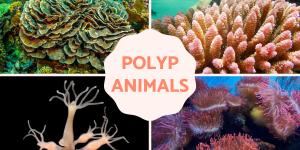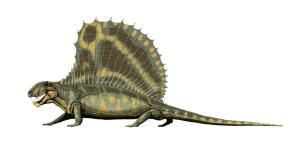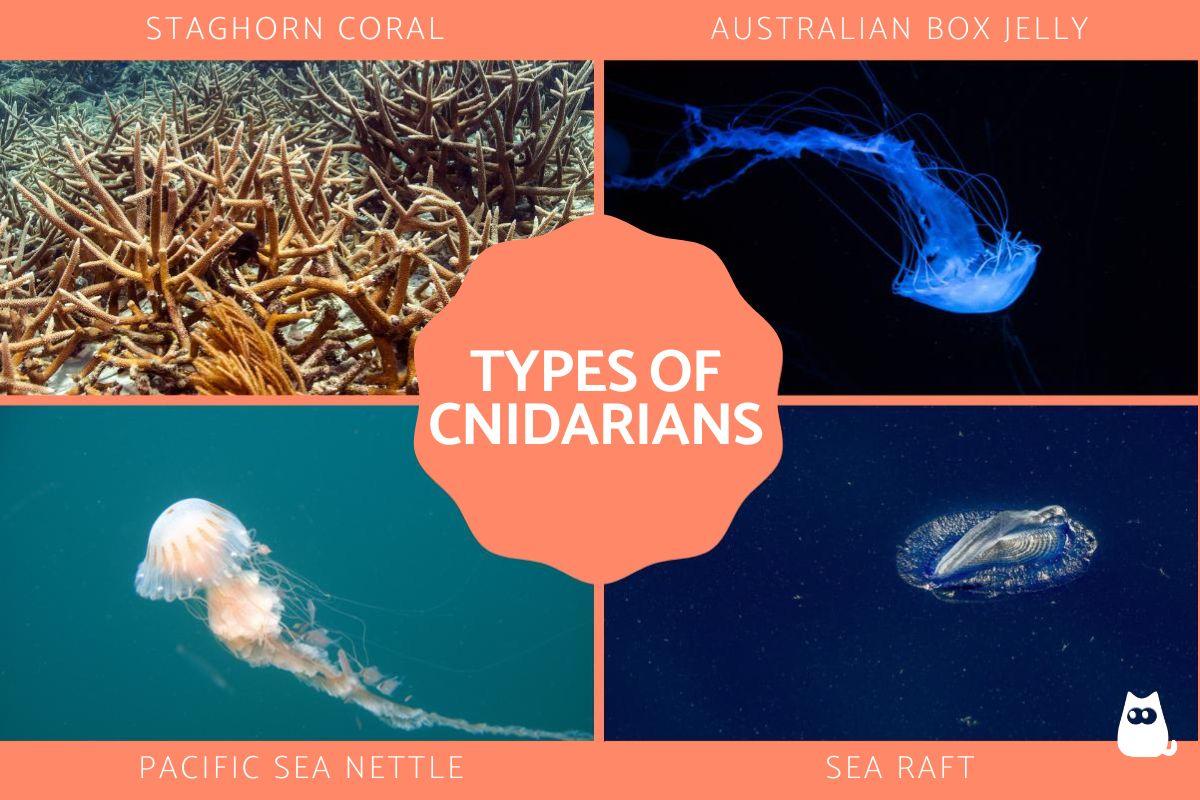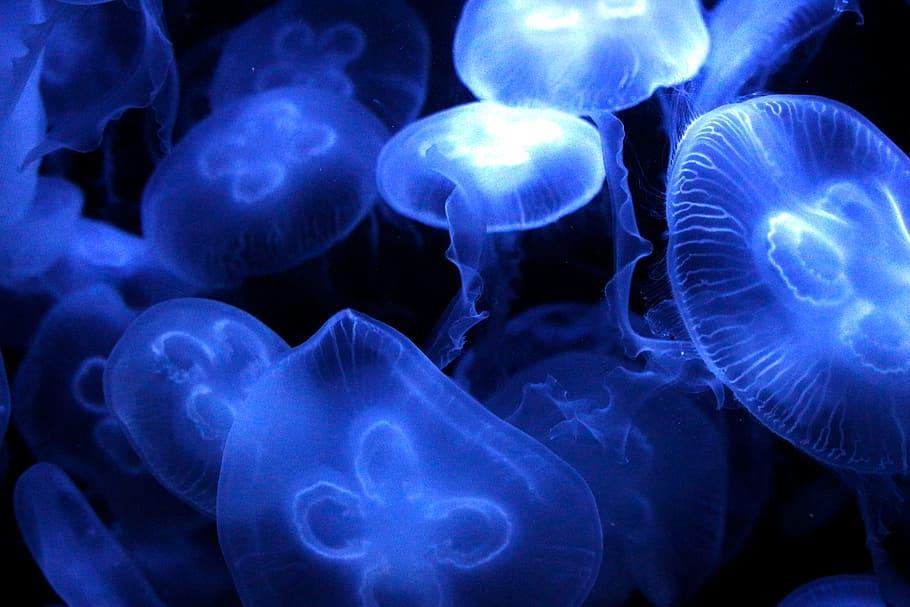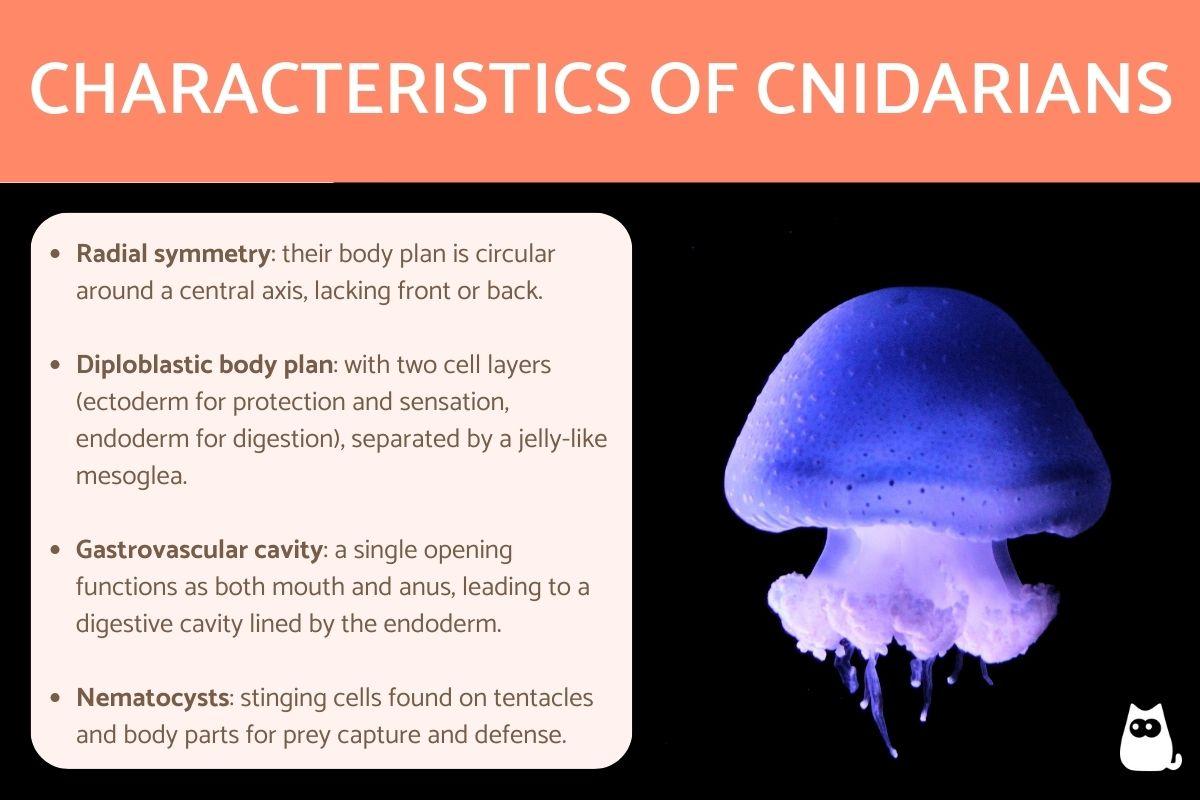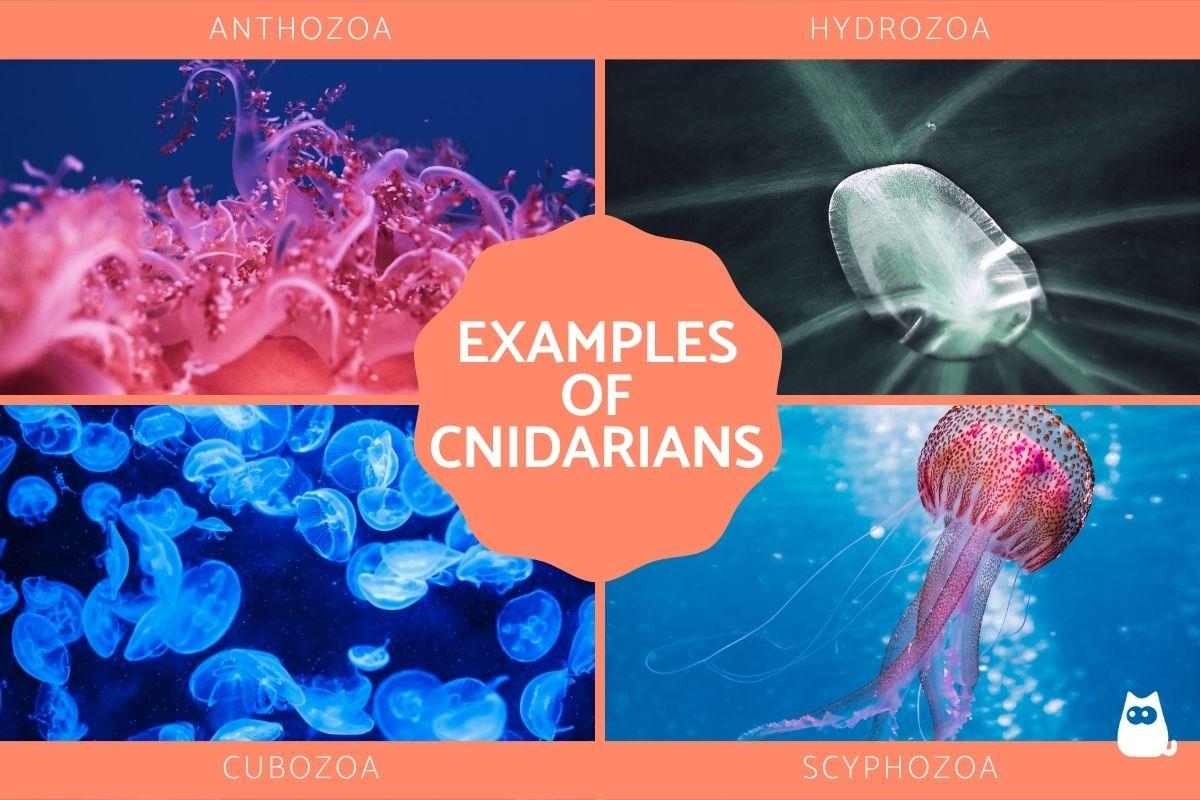What Are Cnidarians? - Types and Characteristics


Cnidarians are a diverse group of aquatic animals that includes jellyfish, corals, sea anemones, and hydras. They are characterized by their radial symmetry, diploblastic body plan, gastrovascular cavity, and nematocysts. Cnidarians can be found in all marine habitats, from the shallowest coral reefs to the deepest oceans. They also occur in some freshwater habitats.
This AnimalWised article will discuss the different types of cnidarians, their characteristics, and how they reproduce, among many other things
What are cnidarians?
Cnidarians are a diverse group of marine animals that belong to the phylum Cnidaria. They are known for their simple body structure, which typically includes a sac-like body with a central cavity and tentacles armed with specialized stinging cells called cnidocytes.
Cnidarians are a group of ancient animals that have been around for at least 500 million years. They are one of the earliest groups of animals to evolve, and their fossils have been found in rocks from all over the world. They are found in all marine habitats, from the shallowest coral reefs to the deepest oceans. Furthermore, they are also found in some freshwater habitats, such as lakes and rivers.
Cnidarians play an important role in marine ecosystems. They are a food source for many other animals, including fish, birds, and sea turtles. They also help to control populations of plankton and other small organisms.

Types of cnidarians
Cnidarians come in various forms and types. There are over 10,000 species of cnidarians, which are divided into four main classes:
Anthozoa
This class includes corals, sea anemones, and sea pens. Anthozoans are primarily sessile, meaning they are attached to the ocean floor. They are typically found in both shallow and deep-sea environments and play a significant role in building coral reefs.
Hydrozoa
Hydrozoa encompasses a diverse group that includes hydras, jellyfish, and siphonophores. Hydrozoans can exhibit both sessile and mobile phases in their life cycle. Some species are solitary, while others form colonies with specialized individuals.
Cubozoa
Cubozoa is the class that comprises box jellyfish. These cnidarians are known for their square-shaped bells and potent stinging cells. Box jellyfish are active predators and are capable swimmers. Some species within this class have venom that can be harmful or even deadly to humans.
Scyphozoa
Scyphozoa includes true jellyfish. These cnidarians are typically mobile and can be found in oceans worldwide. They have a characteristic bell-shaped body with trailing tentacles armed with stinging cells. Some scyphozoans, like moon jellyfish, are commonly encountered in coastal waters.
Characteristics of cnidarians
Cnidarians are a diverse phylum of animals with a wide range of forms and adaptations. While it can be challenging to identify a single set of traits that applies to all cnidarians, there are a few key characteristics that are shared by all members of this phylum.
- Radial symmetry: cnidarians have a body plan that is arranged in a circular pattern around a central axis. This means that they have multiple planes of symmetry, as opposed to biateral symmetry, which is characterized by a single plane of symmetry.
- Two tissue layers: cnidarians have two layers of cells: an ectoderm (outer layer) and an endoderm (inner layer). The ectoderm contains sensory cells, stinging cells, and muscle cells. The endoderm contains digestive cells.
- Gastrovascular cavity: cnidarians have a single digestive opening that serves as both a mouth and an anus. This opening leads into a gastrovascular cavity, which is a central cavity that functions in both digestion and circulation.
- Nematocysts: cnidarians have specialized stinging cells called nematocysts. Nematocysts contain a coiled thread that can be ejected when the cell is triggered. The thread injects venom into the victim, which can cause paralysis or death.
- Polymorphism: some cnidarians exhibit polymorphism, meaning that they have different body forms at different stages of their life cycle. For example, some jellyfish have a medusa stage (free-swimming) and a polyp stage (sessile).
- Simple structures: cnidarians come in a variety of shapes and sizes, but they are all relatively simple animals. They lack a brain, central nervous system, and circulatory system. Instead, they have a nerve net that coordinates their movements.
- Diet: cnidarians are carnivores and use their nematocysts to capture prey. Nematocysts are tiny capsules that contain a coiled thread. When a nematocyst is triggered, the thread shoots out and injects venom into the victim.
- Reproduction: cnidarians can reproduce both sexually and asexually.
If you're curious about the evolution of invertebrates, read this other article.

Habitat of cnidarians
Cnidarians inhabit a wide range of aquatic environments, from the ocean depths to shallow coastal areas. Their distribution is primarily determined by factors such as water temperature, salinity, and food availability. They have adapted to a wide range of habitats by developing a variety of body forms and feeding strategies.
Here are some common cnidarian habitats:
- Coral reefs: Corals are colonial cnidarians that build intricate and diverse underwater landscapes. They thrive in warm, tropical waters with clear, sunlit conditions.
- Intertidal zones: Some cnidarians, such as sea anemones and certain types of hydroids, can be found in intertidal zones along coastlines. These areas experience periodic exposure to air and tidal fluctuations.
- Open ocean: Many jellyfish are pelagic, meaning they live in the open ocean. They can be found at various depths, from the surface to deep waters, and may drift with ocean currents.
- Deep-sea environments: Some cnidarians, including deep-sea corals and anemones, thrive in the cold and dark depths of the ocean. These deep-sea cnidarians often attach to hard substrates like rocks or shipwrecks.
- Freshwater ecosystems: A few cnidarians, such as freshwater jellyfish and certain hydroids, can be found in freshwater environments like lakes and rivers.
- Marine caves and crevices: Cnidarians can inhabit caves, crevices, and overhangs in rocky marine environments. These locations provide shelter and protection from strong currents.
- Substrate attachment: Many cnidarians, such as coral polyps and some anemones, attach themselves to solid substrates such as rocks, shells, or the ocean floor. This attachment provides stability and helps them capture prey.
- Artificial structures: Cnidarians can also colonize artificial structures like piers, docks, and shipwrecks in coastal areas, as long as the environmental conditions are suitable.
If you're interested in learning more about the different types of organisms that make up the ocean food chain, check out this article.
Diet of cnidarians
The diet of cnidarians varies depending on their specific type (e.g., polyps, jellyfish, corals) and the environment in which they live. Some cnidarians, such as jellyfish, feed on plankton. Others, such as sea anemones, feed on small fish and crustaceans. Still others, such as coral polyps, feed on algae and other microorganisms.
Cnidarians are primarily carnivorous, and they capture their prey using specialized stinging cells called cnidocytes, which contain harpoon-like structures called nematocysts. When a potential prey item contacts the tentacles of a cnidarian, the nematocysts are discharged, injecting toxins that immobilize or kill the prey. The tentacles then transport the prey to the cnidarian's mouth, located in the center of its body.
While the diet of cnidarians primarily consists of small aquatic organisms, some cnidarians may also engage in symbiotic relationships with photosynthetic algae called zooxanthellae, which provide them with nutrients through photosynthesis. This mutualistic relationship is particularly common in reef-building corals.
To learn more about the hunting and feeding behaviors of carnivores, read this other article.
Reproduction of cnidarians
Cnidarians exhibit a wide range of reproductive strategies, including both sexual and asexual methods. The specific reproductive mechanisms can vary among different cnidarian groups, but here is an overview of their reproductive strategies:
Asexual reproduction
- Budding: many cnidarians, especially polyps, reproduce asexually through a process called budding. Budding involves the formation of small, genetically identical individuals (polyps) that grow as outgrowths from the parent organism. Eventually, these new individuals separate and become independent. In colonial cnidarians, such as some types of hydroids, new individuals can arise through asexual budding within the colony. This enables the colony to expand and occupy more space.
- Fragmentation: some cnidarians can reproduce asexually through fragmentation. This occurs when a portion of the adult organism breaks off, such as due to physical stress or damage, and develops into a new individual.
- Strobilation: in the life cycle of certain jellyfish, known as scyphozoans, asexual reproduction occurs through a process called strobilation. The adult jellyfish produces small, disc-shaped buds called ephyrae, which eventually develop into mature jellyfish.
Sexual Reproduction
- External fertilization: in many cnidarian species, particularly those with a medusa (jellyfish) stage, sexual reproduction involves the release of eggs and sperm into the water. These gametes fuse externally, leading to the formation of a zygote, which develops into a planula larva. The planula larva is a free-swimming, ciliated stage in the cnidarian life cycle. It eventually settles and attaches to a substrate, where it undergoes metamorphosis into a polyp.
- Internal fertilization: in some cases, such as certain corals and hydrozoans, cnidarians engage in internal fertilization. Sperm is transferred directly to the eggs within the female's body. The resulting zygote develops into a planula larva, which is released into the water.
Some cnidarians, particularly hydrozoans, exhibit an alternation of generations in their life cycle. This means they alternate between two different body forms, typically a polyp and a medusa. Each form has its own mode of reproduction. For example, polyps reproduce asexually through budding or fragmentation, while medusae reproduce sexually.
If you're interested in learning more about the different modes of reproduction in animals, check out this article.
Examples of cnidarian
Here are some examples of cnidarian animals from various classes within the phylum Cnidaria:
Anthozoa
- Stony coral (Acropora spp.): stony corals are reef-building cnidarians that construct calcium carbonate exoskeletons. They are a vital component of coral reefs.
- Sea anemone (Actinia spp.): sea anemones are solitary anthozoans that attach to the ocean floor and have stinging tentacles for capturing prey.
- Sea pen (Pennatulacea): sea pens are colonial anthozoans with a soft, flexible body and a structure resembling a quill pen.
Hydrozoa
- Portuguese Man o' War (Physalia physalis): although it resembles a single organism, the Portuguese Man o' War is a colonial hydrozoan made up of specialized polyps for various functions.
- Hydra (Hydra spp.): hydras are small, freshwater hydrozoans known for their simple body structure and tentacles.
Cubozoa
- Irukandji jellyfish (Carukia barnesi): irukandji jellyfish are small but highly venomous box jellyfish found in Australian waters.
- Chironex (Chironex spp.): also known as the sea wasp, certain species of Chironex are among the most venomous jellyfish in the world.
Scyphozoa
- Moon jellyfish (Aurelia aurita): moon jellyfish are common scyphozoans with a translucent, saucer-shaped bell and short, delicate tentacles.
- Lion's mane jellyfish (Cyanea capillata): known for its long, hair-like tentacles, the lion's mane jellyfish is one of the largest cnidarians.
- Sea nettle (Chrysaora quinquecirrha): sea nettles are scyphozoans with distinctive, lacy oral arms and trailing tentacles.
These are just a few examples of the diverse cnidarian species found in oceans, seas, and freshwater environments.

If you want to read similar articles to What Are Cnidarians? - Types and Characteristics, we recommend you visit our Facts about the animal kingdom category.
- ITIS (2022). Cnidaria. Available at: https://www.itis.gov/servlet/SingleRpt/SingleRpt?search_topic=TSN&search_value=48738#null
- Animal Diversity Web (2020). Available at: https://animaldiversity.org/
- Hickman, C.; Roberts, L.; Parson, A. (2000). Comprehensive principles of zoology. McGraw Hill Inter-American: Spain.


